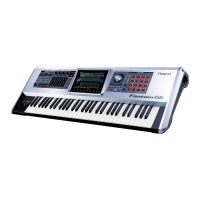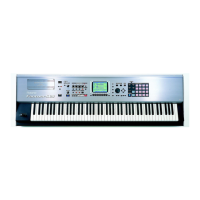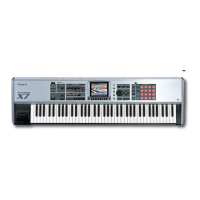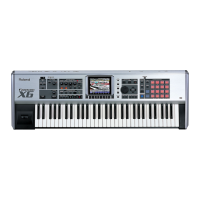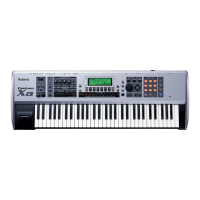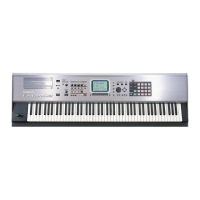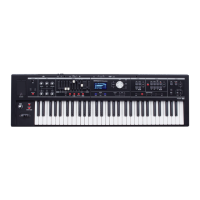250
Editing Songs
Microscope lets you edit individual items of sequencer data recorded
in a phrase, such as MIDI messages.
Access the Microscope screen when you want to view the sequencer
data recorded in a phrase. Each line indicates the location (measure-
beat-tick) at which the sequencer data is recorded, and the data
recorded at that location.
1.
Access the Phrase Edit screen (p. 238).
2.
Press [F4 (Microscope)].
The Microscope screen will appear.
Use / to view the performance data.
fig.19-026.j
F-key operations in the Microscope screen
3.
You can press [F6 (
)] to switch the display of the piano
roll.
4.
Press [F7 (Channel)] to select the part whose performance
data you want to view or edit.
Choose “ALL” if you want to view performance data of all
MIDI channels.
Channel: ALL, 1–16
Part Group: ALL, INT, EXP1, EXP2, EXT
In order to make efficient use of the display space in the screen,
locations in which no performance data exists are normally not
shown.
For an explanation of the various types of performance data,
refer to
“Sequencer Data Handled by Phrases”
(p. 251) .
5.
When you’ve finished editing, press [F8 (Close)].
6.
Use
/ to select the performance data that you want
to edit.
7.
Use
/ to select the parameter that you want to edit.
8.
Turn the VALUE dial or use [INC] [DEC] to change the value.
Notes, the note name (note number) of polyphonic aftertouch
data, and the on-velocity or off-velocity of a note can also be
specified by pressing a note on the keyboard.
If you press [ENTER], the performance data currently indicated
by “
” will be transmitted from the MIDI OUT connector. In
the case of a note message, pressing [ENTER] will sound that
note.
If you’re editing a system exclusive message, refer to “Editing a
system exclusive message” on the following page.
9.
Repeat steps 3 through 8 to edit the data.
10.
To close the Microscope screen, press [EXIT].
You can Undo the result of editing (p. 217).
Editing Individual Items of
Sequencer Data
(Microscope)
Editing Sequencer Data
(Basic Procedure in the Microscope)
F-key
Explanation Page
F1
Create
Inserts data. p. 252
F2
Erase
Erases data. p. 252
F3
Move
Moves data. p. 253
F4
Copy
Copies data. p. 253
F5
Place
Pastes the copied data. p. 253
F6 Switches the display of the piano roll. p. 250
F7
Channel
Switches the part whose data is displayed. p. 250
F8
View
Selects the data that is displayed. p. 252
Location of the performance data
(Measure – Beat – Tick)
Performance data
MIDI channel
Indicates the parameter data
at the cursor location
Part Group
INT
EXP1
EXP2
EXT
Fantom-G_r_e.book 250 ページ 2009年7月2日 木曜日 午後2時55分

